The Green Climate Fund (GCF) aspires to be the Pacific’s Climate Partner of Choice.
Here, I wish to outline how the Fund is committed to partnering with the Pacific to achieve greater impact in the face of the climate crisis.
As leaders gather in Honiara, Solomon Islands, this week for the Pacific Islands Forum, the criticality of ambitious action and collective effort to meet our global climate challenge will again be top of the region’s agenda.
The Pacific faces acute and accelerating climate threats. Sea levels are rising nearly twice as fast as the global average, and marine heat waves have doubled in frequency. The cost of climate-related disasters has surged eightfold in the past decade, reaching US$ 7.3 billion.
Despite contributing just 0.03% of global greenhouse gas emissions, Pacific Island countries have consistently demonstrated global leadership on the climate agenda, including by aligning their Nationally Determined Contributions (NDCs) and national policies with the global target to limit warming to 1.5°C by the end of the century.
At the same time, the region’s island nations are pioneering adaptation strategies, building resilient infrastructure, and leading the global conversation on climate justice. The Pacific is not waiting for solutions—it is creating them.
At the Green Climate Fund (GCF), we are committed to supporting such leadership by delivering climate finance at scale, strengthening institutions, and partnering with stakeholders in the Pacific to deliver impact.
Since March 2023, the Fund’s investment in the Pacific has increased from US$514 million to US$846 million. That represents a clear statement of intent and how the Pacific is a priority region for the Fund. Our partner organizations (GCF Accredited Entities) implement projects on the ground. In the Pacific, several regional agencies are now playing this role, along with national ministries of finance and development banks.
The catalytic nature of this investment is significant. Globally, GCF’s US$18 billion of committed investment has multiplied to US$ 66.6 billion when additional mobilized co-investment is included. The Fund is proving increasingly adept at unlocking additional funding from private investors, philanthropies, and other governments. Its flexible capital stack and risk appetite allow it to take first-loss positions, derisk projects, and crowd in significantly more investment to maximise impact for our partner countries.
GCF is the only climate fund with a balanced board of developed and developing countries (including representation from Kiribati and Australia on the current board). This, and a recent board decision to establish a regional presence, positions the Fund to further enhance country and regional ownership of climate action.
The Fund’s current portfolio spans all 14 Pacific Small Island Developing States (SIDS), all of which have successfully accessed GCF funds. These investments are transforming lives and providing examples of innovative climate action for SIDS and other countries around the world.
This dramatic increase has been facilitated by reforms that enhance efforts to strengthen national institutions and accelerate access to finance. Our Readiness Programme—the world’s largest climate capacity-building initiative—is now more predictable and tailored to country needs. Pacific nations can access up to US$ 7 million each over four years to strengthen national adaptation plans and project pipelines, with additional resources available for Pacific accredited entities
Seven Pacific partners are now accredited to implement GCF projects, with five already doing so in addition to international accredited entities. The Fund is engaging productively with these Pacific organizations, enabling them to lead on Pacific solutions with global support.
Across the Pacific, GCF is financing a landmark climate project to protect tuna stocks that will directly or indirectly benefit almost 25 per cent of the region’s population. The US$ 156.7 million investment, of which US$ 107.4 million is a GCF grant, will strengthen food security and livelihoods in communities in 14 island countries. Conservation International, in partnership with the Pacific Community (SPC), is leading implementation of the project, which will enhance coastal and urban communities’ access to tuna, strengthen national fisheries systems, and improve forecasting to manage tuna redistribution effectively.
In the Cook Islands, GCF is financing its first health sector climate project in the Pacific. The “One Block at a Time” initiative is strengthening the resilience of health systems and services across 12 islands, supporting 30 communities and 22 health facilities. Developed and led by the Cook Islands Ministry of Finance and Economic Management, this US$12.5 million investment is a model of country ownership and innovation. It demonstrates how climate finance can be tailored to meet local needs—through health assessments, pre-feasibility studies, and community engagement—and offers a blueprint for other island nations facing similar vulnerabilities.
Next week, I will be in Australia speaking with senior officials and partners about how we can further scale up our climate ambitions and actions in the Pacific. The upcoming COP30, hosted in Brazil, and future COPs, wherever they are hosted, are opportunities to strengthen regional cooperation on key pillars of the climate agenda and demonstrate the benefits of an enhanced partnership between Australia and Pacific SIDS, as well as support from GCF.
In November, GCF marks 10 years of climate investments. As we reflect on our progress, we are more committed than ever to channelling resources to the Pacific, supporting the region’s lead on transformational adaptation efforts in the face of the climate crisis. Together we can demonstrate the value and effectiveness of multilateral action on climate.
By Hemant Mandal
Green Climate Fund (GCF)’s Director
of Asia and the Pacific Region.

